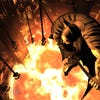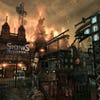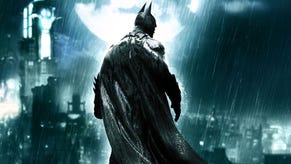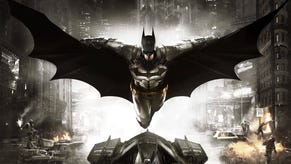Batman: Arkham City
Where does he get those wonderful toys?
The crust of the city, meanwhile, is exactly as you always wanted Gotham to be: covered in dirty snow and trash, latticed by searchlights and ramshackle Victorian fixtures. It's filled with Riddler's trophies in much expanded form - the best of them now creating the basis of an endlessly inventive series of pressure-plate puzzles, electrical mazes and remote-controlled Batarang gauntlets - and also with secrets for super-fans to spot. Here's the Monarch Theatre where Thomas and Martha Wayne were gunned down. There's a fleeting glimpse of a Harvey Dent campaign poster. I believe in that guy.
In other words, if Arkham Asylum was Metroid - a claustrophobic, tightly contained and intricate blend of gear-gating and backtracking - this is The Legend of Zelda: a sustained head-rush of deftly-controlled freedom with landmark Gotham buildings as the dungeons, while the streets themselves stand in for the rolling fields of Hyrule.
These streets are also home to random brawls, dozens of collectables and a smart range of side-quests, each one terminating with a famous name, each one hinging on an appealing mechanic. Whether you're patrolling the skies and hunting for the remains of a serial killer's victims or racing from one ringing phone booth to the next to trace a scrambled call, there are webs of distraction waiting for you everywhere you look.
It's hard not to be drawn in. Those question mark trophies, for example, which once landed you with a mere Achievement or two and some unlocks, now lead to what amounts to a small campaign in its own right - and the Riddler's far from the only Asylum alumnus who's been promoted in a surprising fashion.
The true surprise, though, isn't the new scope or the new cast, but the traversal. Arkham Asylum delivered a Batman so effortlessly tailored for videogames - unbeatable in a fistfight, useless under gunfire, equally at home plotting a spot of violence and deconstructing a crime scene - that you could be forgiven for not realising you only ever got half of him. Now, Rocksteady is handing over the rest, putting Batman right where he belongs: in the night sky.
Certainly, grappling and gliding were both available in the first game, but they were severely limited. The latter, in particular, had one tantalising cliff-top outing and was then reserved primarily for a dreamy prelude to a boot in somebody's face. Here, both have been thrust centre stage with the addition of a grapple boost (which fires you up into the clouds as a kind of running start) and a large open space to then coast over, cape billowing. Suddenly, Arkham City, like Crackdown and Just Cause 2, has become one of those games that's all about the pleasure of simply getting around. And that's one of the canniest, most overlooked and most essential pleasures that a game can home in on.
To cope with the larger scale, there's a new radar at the top of the screen and the ability to set custom waypoints (they show up, of course, as the Bat Signal). Both disappear when you switch to Detective Mode - a smart piece of rebalancing that should ensure players get to see more of the art team's actual texturing this time around. You'll need all the navigation help you can get, too.
It's true that Arkham City's not an enormously vast open-world, even when you take into account all the indoor levels that punctuate the main campaign, but it's intricate and it's filled with secrets. After four days of protracted Batexploration I was still discovering new things - and the game's best moments are often its most peaceful, as you ghost over the landscape, your earpiece delivering constant radio chatter from the criminals milling around below. At times, it's hard not to feel like the world's greatest detective, on patrol, sifting through all that noise and looking for the one signal that will send you into action.











